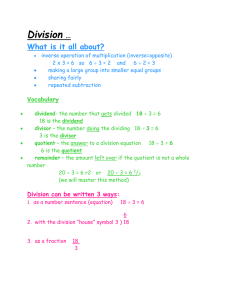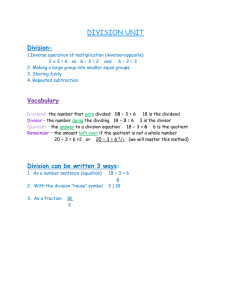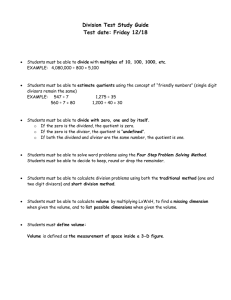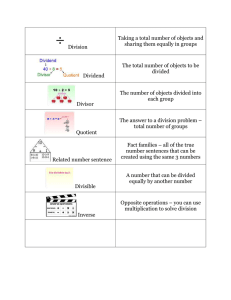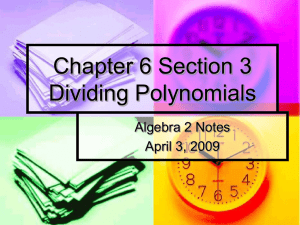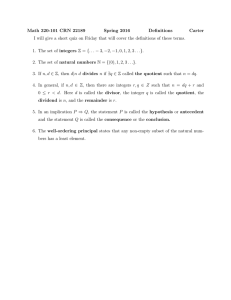Estimating Sums and Differences When an exact answer is not
advertisement
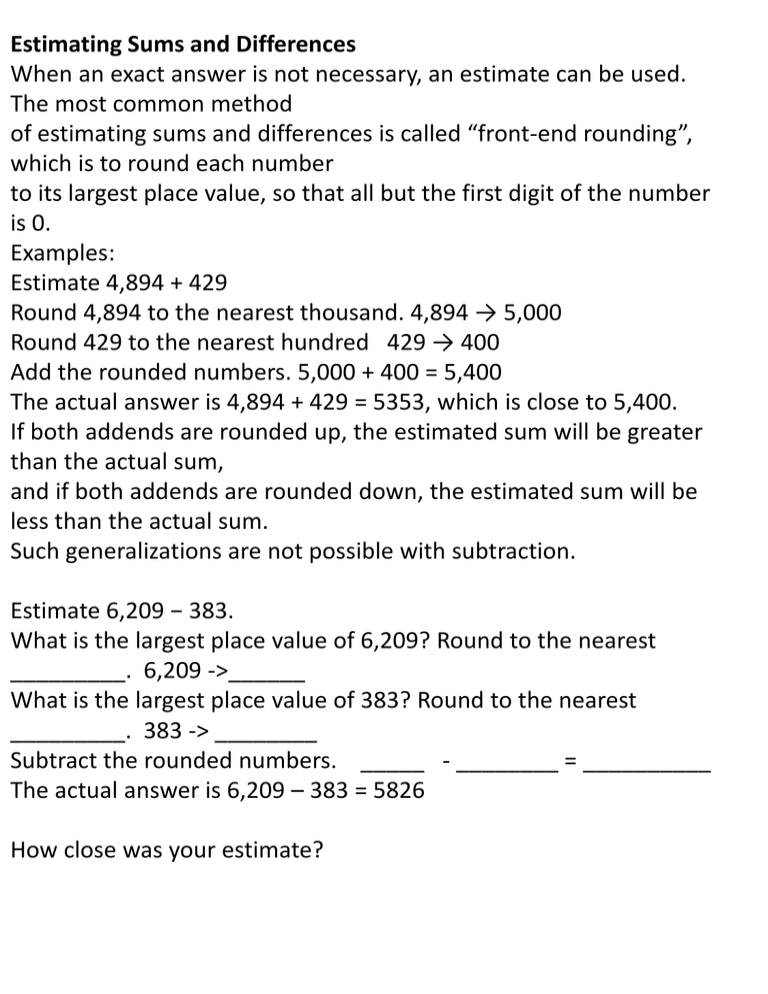
Estimating Sums and Differences When an exact answer is not necessary, an estimate can be used. The most common method of estimating sums and differences is called “front-end rounding”, which is to round each number to its largest place value, so that all but the first digit of the number is 0. Examples: Estimate 4,894 + 429 Round 4,894 to the nearest thousand. 4,894 → 5,000 Round 429 to the nearest hundred 429 → 400 Add the rounded numbers. 5,000 + 400 = 5,400 The actual answer is 4,894 + 429 = 5353, which is close to 5,400. If both addends are rounded up, the estimated sum will be greater than the actual sum, and if both addends are rounded down, the estimated sum will be less than the actual sum. Such generalizations are not possible with subtraction. Estimate 6,209 − 383. What is the largest place value of 6,209? Round to the nearest _________. 6,209 ->______ What is the largest place value of 383? Round to the nearest _________. 383 -> ________ Subtract the rounded numbers. _____ - ________ = __________ The actual answer is 6,209 – 383 = 5826 How close was your estimate? Multiplying Whole Numbers Multiplication: 5 x 4 = 5 ● 4 = 5(4) = 20 factors product Other terms for multiplication: times, multiplied by, of. Multiplication Properties of 0 and 1: a ●0 = 0 Example: 4 ● 0 = 0 + 0 + 0 + 0 = 0 a ●1 = a Example: 4 ● 1 = 1 + 1 + 1 + 1 = 4 Multiplication by Multiples of 10 When one or more factors is a multiple of 10, such as 20, 80, or 300, you may temporarily ignore such ending zeros and include them together in the final product. 30·90 Count the ending zeros…two. Calculate the product of the leading digits: 3·9 = 27. Attach the two zeros and the final answer is 2700. 5,010·200 There are 3 ending zeroes, the zero between 5 and 1 doesn’t count because it’s in the middle. 501·2 = 1002, attach the three zeros and the final answer is 1002000 = 1,002,000 Commutative Property: a ● b = b ● a 5● 4=4● 5 Associative Property: (a ● b) ● c = a ● (b ● c) 21 ● 6 = 21 ● (3 ● 2)= (21 ● 3) ● 2 = 63 ● 2 = 126 IMPORTANT!! The commutative and associative properties are only in effect when an expression is either ALL addition or ALL multiplication. Distributive Property: a ● (b+ c) = a ● b + a ● c 2● (4+ 5) = 2 ● 4 + 2 ● 5 = 8 + 10 = 18 Relevance of Distributive Property: If you don’t know a product through mental math, you can break up one of the factors into a sum that will allow you to do mental math. Example a) Multiply 6 x15 If you don’t now what 6 times 14 is, you can break up 14 into a sum of 10 and 4, then use the distributive property. 6 x15 =6x(10+ 5) = 6 x10 + 6 x5 = 60 + 30 = 90 If you don’t know what 450 + 90 is, ho much do you need to count up from 450 to get to 500? 50, right? How much more to add 90? 50 + 40 = 90, so from 500 I just add 40 more. a) Multiply 15 x 36 Mentally… 15 x 36 = 15(30 + 6) = 15x30 + 15x6 = 450 + 90 = 450 + 50 + 40 = 540 Using a pencil and paper… Example: Mileage Specifications for a Ford Explorer 4x4 are shown in the table below. How far can it travel on a tank of gas? mpg means Miles per Gal = miles/gal Engine 4.0 L V6 Fuel Capacity 21 gal Fuel economy (mpg) 15 city/ 19 hwy Number of gallons in 1 tank We are being asked to find “how far”, which is a distance. Distance is measured in miles. We will assume this distance is traveled in the city so we’ll use city mileage (15 mpg). Dimensional analysis is used to convert units. We are given miles per gal and gallons per tank. We want to know how many miles can be traveled on 1 tank. 15miles 21gal 15 21 315 miles/tank gal tank Note: if you don’t know what 15 x 21 is doing mental math, you can do it using the distributive property: 15 x 21 = 15(20+1) = 15(20) + 15(1) = 300+15=315 Example: Calculating production The labor force of an electronics firm works two 8-hour shifts each day and manufactures 53 TV sets each hour. Find how many sets will be manufactured in 5 days. We are looking for the number of TV sets manufactured in 5 days. Use Dimensional Analysis. We are given TV sets manufactured per hour, and hours worked per shift, and shifts worked per day. If you included all the pertinent information, you should have cancelled out all the unnecessary units (like units on top cancel out like units on the bottom), and the units left should be “TV sets”, which is what we want. 2 shifts 8 hours 53 TV sets 5 days 2 8 53 5 4240 day shift hour Using the commutative and distributive properties of multiplication we could we regroup these numbers for easier mental math. 2*5=10, 8*53 = 8*(50+3) = 400+24=424 10*424=4240 Rectangular Patterns If you have a rectangular pattern objects, such as rows and columns, you can determine the total number of objects by multiplying the number of rows times the number of columns (or objects per row). Example: Our classroom has 7 rows with 6 seats in each row. Therefore our classroom can hold 7x 6 = 42 people. Area: The area of a rectangle is length x width= lw The is the amount of area covered within the rectangle. If length is in inches, and width is in inches, Area = length x width means the units of the Area are inch2, or “square inches” Example 1) Find the area: Example 2) Find the area: Note that since a square is just a rectangle whose length and width equal each other, you just have to know 1 side, and then multiply it by itself. Example 3) Find the area: Dividing Whole Numbers Standard form Fraction form Long Division Form 5 10 10 2 10 / 2 5, also we can do it this way : 2 10 2 Dividend Divisor Quotient Divisor Quotient Dividend All these operation symbols mean the same thing: “10 divided by 2 is 5” Quotient Divisor Dividend * Math Doesn't Suck, How to Survive Middle School Math Without Losing Your Mind Or Breaking a Nail – Danica McKellar Division Properties: Division is the “inverse” of multiplication. That is, does the opposite of what multiplying does. a(b) = c If a times b is c, then c/b answers the question, “c times what equals b?” and c/a answers the question, “c times what equals a?” a = c/b b = c/a Division with 0 If a represents any nonzero number, 0/a = 0 If a represents any nonzero number, a/0 is undefined. 0/0 is undetermined. More Division Properties a/1 = a a/a = 1 (provided that a≠0) Checking Division: Quotient X Divisor + Remainder = Dividend Translation: The answer to the division problem times the number you divided by, plus the remainder, should equal the number you divided into. 16/2 leaves no remainder, so remainder = 0 8x2 +0 = 16 What about 16/3? 5 R1 3 16 -15 1 Check: Quotient X Divisor + Remainder = Dividend 5 x 3 + 1 = 15+1=16 yes What is 245 divided by 8? The first digit of your dividend is 2. Ask yourself, does 8 go into 2? No, so put a 0 (or gap) above the 2 and go to the next digit. Does 8 go into 24? Yes, it goes 3 times. So put a 3 above the 4 in the quotient space. 3 x 8 is 24, and 24-24 is 0, but you are not done because there is another digit in the dividend, which is 5. Bring down the 5 and ask yourself, does 8 go into 5? No, so put a 0 above the 5 in the quotient space. 0 x 8 = 0, and 5 – 0 = 5. There are no more digits to bring down from the dividend. So you are done. 5 is the remainder. Check: Quotient x Divisor + Remainder = Dividend Does 30 x 8 + 5 = 245? 240 + 5 = 245 Yes! 506 R28 62 31400 -310 400 -372 28 Remainder For example: If 62 people had the winning lottery ticket for $31,400, each would receive $506, and there would be $28 leftover. Who get’s it? Where do we start? We first only look at the first few digits of the “dividend,” which is 31400. What is the smallest number among those digits that 62 can go into? 3 is too small 31 is too small. 314 is big enough. The first digit of the quotient will be above the 4. Now choose a number that you think when multiplied by 62, will be close to 314. How? Estimate by rounding 62 down to 60, and rounding 314 down to 300. We know 300/60 = 30/6 = 5, so let’s try 5 x 62, which is 310. This is close to 314. Subtract 314-310 = 4. 62 does not go into 4 so bring down the next digit of 31400, which is 0. Does 62 go into 40? No, so we must put a 0 in that place value after 5. (There must be a digit in the quotient (answer) above every digit in the dividend. So we must put a 0 before going to the next digit). Now bring down the next digit of 31400, which is 0. This gives us 400. Does 62 go into 400? Rounding down to estimate we know 60x6=360, which is getting close, and 62x6=372, this is the closest we’re gong to get to 400 without going over, so let’s try 6. Subtract 400-372 = 28. There are no more digits to bring down, so 28 is the remainder. Example A total of 216 girls tried out for a city volleyball program. How many girls should be put on the team roster if the following requirements must be met? 1)All the teams must have the same number of players. (find a number that goes exactly into 216, so there is no remainder) 2) A reasonable number of players on a team is 7 to 10 (divide 216 players by 7 players per team, then 8, then 9, then 10). But don’t bother with 10 because we know 10 doesn’t go exactly into 216. 3) There must be an even number of teams. (The quotient must be EVEN). 6<7, and there are no more digits left to carry down, so 6 is the remainder and 216 is not exactly divisible by 7. 3 7 216 21 6 27 8 216 16 56 56 0 8 goes exactly into 216, but the quotient is 27, which is ODD. (Does not meet 3rd req.) 24 9 216 18 36 36 0 This meets all 3 requirements: 9 players per team leaves no remainder, 9 is an acceptable number for a team (which is a number between 7 and 10), and the number of teams is 24, which is an even number.
